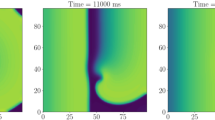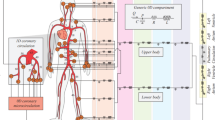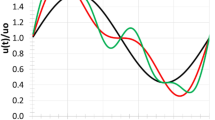Abstract
Controlling the complex spatio-temporal dynamics underlying life-threatening cardiac arrhythmias such as fibrillation is extremely difficult, because of the nonlinear interaction of excitation waves in a heterogeneous anatomical substrate1,2,3,4. In the absence of a better strategy, strong, globally resetting electrical shocks remain the only reliable treatment for cardiac fibrillation5,6,7. Here we establish the relationship between the response of the tissue to an electric field and the spatial distribution of heterogeneities in the scale-free coronary vascular structure. We show that in response to a pulsed electric field, E, these heterogeneities serve as nucleation sites for the generation of intramural electrical waves with a source density ρ(E) and a characteristic time, τ, for tissue depolarization that obeys the power law τ ∝ Eα. These intramural wave sources permit targeting of electrical turbulence near the cores of the vortices of electrical activity that drive complex fibrillatory dynamics. We show in vitro that simultaneous and direct access to multiple vortex cores results in rapid synchronization of cardiac tissue and therefore, efficient termination of fibrillation. Using this control strategy, we demonstrate low-energy termination of fibrillation in vivo. Our results give new insights into the mechanisms and dynamics underlying the control of spatio-temporal chaos in heterogeneous excitable media and provide new research perspectives towards alternative, life-saving low-energy defibrillation techniques.
This is a preview of subscription content, access via your institution
Access options
Subscribe to this journal
Receive 51 print issues and online access
$199.00 per year
only $3.90 per issue
Buy this article
- Purchase on Springer Link
- Instant access to full article PDF
Prices may be subject to local taxes which are calculated during checkout




Similar content being viewed by others
References
Davidenko, J. M., Pertsov, A. V., Salomonsz, R., Baxter, W. & Jalife, J. Stationary and drifting spiral waves of excitation in isolated cardiac muscle. Nature 355, 349–351 (1992)
Gray, R. A., Pertsov, A. M. & Jalife, J. Spatial and temporal organization during cardiac fibrillation. Nature 392, 75–78 (1998)
Witkowski, F. X. et al. Spatiotemporal evolution of ventricular fibrillation. Nature 392, 78–82 (1998)
Cherry, E. M. & Fenton, F. H. Visualization of spiral and scroll waves in simulated and experimental cardiac tissue. New J. Phys. 10, 125016–125059 (2008)
Koster, R. W. et al. A randomized trial comparing monophasic and biphasic waveform shocks for external cardioversion of atrial fibrillation. Am. Heart J. 147, e1–e7 (2004)
Babbs, C. F., Tacker, W. A., VanVleet, J. F., Bourland, J. D. & Geddes, L. A. Therapeutic indices for transchest defibrillator shocks: effective, damaging, and lethal electrical doses. Am. Heart J. 99, 734–738 (1980)
Santini, M. et al. Single shock endocavitary low energy intracardiac cardioversion of chronic atrial fibrillation. J. Interv. Card. Electrophysiol. 3, 45–51 (1999)
Sakurai, T., Mihaliuk, E., Chirila, F. & Showalter, K. Design and control of wave propagation in excitable media. Science 296, 2009–2012 (2002)
Rappel, W. J., Fenton, F. H. & Karma, A. Spatiotemporal control of wave instabilities in cardiac tissue. Phys. Rev. Lett. 83, 456–459 (1999)
Biktashev, V. N., Holden, A. V. & Zhang, H. Tension of organizing filaments of scroll waves. Phil. Trans. R. Soc. Lond. A 347, 611–630 (1994)
Fenton, F. H., Cherry, E. M., Hastings, H. M. & Evans, S. J. Multiple mechanisms of spiral wave breakup in a model of cardiac electrical activity. Chaos 12, 852–892 (2002)
Fenton, F. H. & Karma, A. Vortex dynamics in three-dimensional continuous myocardium with fiber rotation: Filament instability and fibrillation. Chaos 8, 20–47 (1998)
Mackenzie, D. Making sense of a heart gone wild. Science 303, 786–787 (2004)
Walcott, G. P., Killingsworth, C. R. & Ideker, R. E. Do clinically relevant transthoracic defibrillation energies cause myocardial damage and dysfunction? Resuscitation 59, 59–70 (2003)
Fenton, F. H. et al. Termination of atrial fibrillation using pulsed low-energy far-field stimulation. Circulation 120, 467–476 (2009)
Plonsey, R. The nature of sources of bioelectric and biomagnetic fields. Biophys. J. 39, 309–312 (1982)
Fast, V. G., Rohr, S., Gillis, A. M. & Kléber, A. G. Activation of cardiac tissue by extracellular electrical shocks: Formation of ‘secondary sources’ at intercellular clefts in monolayers of cultured myocytes. Circ. Res. 82, 375–385 (1998)
Sambelashvili, A. T., Nikolski, V. P. & Efimov, I. R. Virtual electrode theory explains pacing threshold increase caused by cardiac tissue damage. Am. J. Physiol. Heart Circ. Physiol. 286, H2183–H2194 (2004)
Hooks, D. A. et al. Cardiac microstructure: Implications for electrical propagation and defibrillation in the heart. Circ. Res. 91, 331–338 (2002)
Trayanova, N. & Skouibine, K. Modeling defibrillation: Effects of fiber curvature. J. Electrocardiol. 31 (suppl.). 23–29 (1998)
Pumir, A. & Krinsky, V. Unpinning of a rotating wave in cardiac muscle by an electric field. J. Theor. Biol. 199, 311–319 (1999)
Roth, B. J. & Wikswo, J. P. A bi-domain model for the extracellular potential and magnetic field of cardiac tissue. IEEE Trans. Biomed. Eng. 33, 467–469 (1986)
Murray, C. D. The physiological principle of minimum work: I. The vascular system and the cost of blood volume. Proc. Natl Acad. Sci. USA 12, 207–214 (1926)
Kassab, G. S. Scaling laws of vascular trees: of form and function. Am. J. Physiol. Heart Circ. Physiol. 290, H894–H903 (2006)
Maleckar, M. M. et al. Polarity reversal lowers activation time during diastolic field stimulation of the rabbit ventricles: insights into mechanisms. Am. J. Physiol. Heart Circ. Physiol. 295, H1626–H1633 (2008)
Ripplinger, C. M., Krinsky, V. I., Nikolski, V. P. & Efimov, I. R. Mechanisms of unpinning and termination of ventricular tachycardia. Am. J. Physiol. Heart Circ. Physiol. 291, H184–H192 (2006)
Takagi, S. et al. Unpinning and removal of a rotating wave in cardiac muscle. Phys. Rev. Lett. 93, 058101 (2004)
Kirchhof, C. et al. Regional entrainment of atrial fibrillation studied by high-resolution mapping in open-chest dogs. Circulation 88, 736–749 (1993)
Pumir, A. et al. Wave emission from heterogeneities opens a way to controlling chaos in the heart. Phys. Rev. Lett. 99, 208101 (2007)
Gray, R. & Chattipakorn, N. Termination of spiral waves during cardiac fibrillation via shock-induced phase resetting. Proc. Natl Acad. Sci. USA 102, 4672–4677 (2005)
Acknowledgements
We thank M. L. Riccio and the Cornell University μCT Facility for Imaging and Preclinical Research for performing the micro-CT scanning, and T. K. Hitchens for technical assistance with cardiac structural imaging. M. W. Enyeart and J. Boesch assisted with the experiments and N. F. Otani provided insights from computer simulations. G. Hooker conducted the statistical analysis. This work was supported by National Science Foundation (NSF) grants 0800793 (F.H.F. and E.M.C.) and 0926190 (F.H.F.); by National Institutes of Health (NIH) grants HL075515-S04 (F.H.F.), HL075515 (R.F.G.) and HL073644 (R.F.G. and E.B.); by IFCPAR Project no. 3404-4 (A.P.); by the German Ministry for Education and Research through FKZ 01EZ0905/6 (S.L., M.Z., E.B. and G.H.); by the Kavli Institute for Theoretical Physics through NSFPHY05-51164; by the Pittsburgh Supercomputing Center (NSF TeraGrid); by the Pittsburgh NMR Center for Biomedical Research (NIH P41-EB001977); by the European Community’s Seventh Framework Programme FP7/2007–2013 agreement HEALTH-F2-2009-241526 (EUTrigTreat) and by the Max Planck Society.
Author information
Authors and Affiliations
Contributions
E.B., F.H.F., R.F.G., V.I.K., S.L. and A.P. designed research and wrote the paper with P.B., E.M.C., G.H., D.H., B.G.K. and A.S. P.B., F.H.F., S.L. and A.S. did the in vitro experiments and analysed the data. L.C., F.H.F., J.F., R.F.G., A.G., G.H., B.G.K., S.L., A.S. and M.Z. contributed to the in vivo experiments and F.H.F. and S.L. analysed the data. P.B., F.H.F. and A.S. did the CT scanning; P.B., E.B., E.M.C., F.H.F., D.H., V.I.K., G.L., S.L., A.P. and A.S. analysed and interpreted the data.
Corresponding authors
Ethics declarations
Competing interests
The authors declare no competing financial interests.
Supplementary information
Supplementary Information
The file contains Supplementary Text, Supplementary Figures 1-13 with legends, Supplementary Tables 1-4 and additional references. (PDF 2300 kb)
Supplementary Movie 1
The movie shows atrial fibrillation (AF) and successful termination of AF (see Fig. 1c and e).The color indicates membrane potential (black = resting, red activated;c.f. color bar given in Fig. 1e).The times of the five AFP pulses are indicated by a red square. The field of view is 4 x 4 cm2.Note that during AFP, waves originate both from boundaries and form inside the tissue. (MOV 2760 kb)
Supplementary Movie 2
The movie shows normal sinus rhythm (see Fig. 1e).The color indicates membrane potential (black = resting, red activated;c.f. color bar given in Fig. 1e).The field of view is 4 x 4 cm^2. (MOV 687 kb)
Supplementary Movie 3
The movie shows representative examples of wave propagation in quiescent tissue induced by weak electric field pulses with E = 0.22 V/cm, E = 0.39 V/cm and E = 0.5 V/cm, respectively (pulse duration 8 ms).The color indicated time (early = red, late = blue; see Fig. 2). (MOV 285 kb)
Supplementary Movie 4
The movies (5-7) shows simulations corresponding to Figure S10, panels AD.The simulations have been done using the Barkley model.The color indicates the fast activator variable (blue = resting, red = activated).The text at the beginning of each video indicates pacing sites and relative frequencies.During the simulations, phase singularity trajectories are tracked where appropriate (indicated by white color). (MOV 1041 kb)
Supplementary Movie 5
Please read legend for Supplementary Movie 4. (MOV 5312 kb)
Supplementary Movie 6
Please read legend for Supplementary Movie 4. (MOV 5456 kb)
Supplementary Movie 7
Please read legend for Supplementary Movie 4. (MOV 1438 kb)
Supplementary Movie 8
The movie shows AF and successful termination using direct access to the core (Fig. 4e).The color indicates membrane potential (black = resting, red activated;c.f. color bar given in Fig. 4d).The times of the five AFP pulses are indicated by a red square. The field of view is 4 x 4 cm2. (MOV 2038 kb)
Rights and permissions
About this article
Cite this article
Luther, S., Fenton, F., Kornreich, B. et al. Low-energy control of electrical turbulence in the heart. Nature 475, 235–239 (2011). https://doi.org/10.1038/nature10216
Received:
Accepted:
Published:
Issue Date:
DOI: https://doi.org/10.1038/nature10216
This article is cited by
-
In silico optical modulation of spiral wave trajectories in cardiac tissue
Pflügers Archiv - European Journal of Physiology (2023)
-
Optogenetic Modulation of Arrhythmia Triggers: Proof-of-Concept from Computational Modeling
Cellular and Molecular Bioengineering (2023)
-
Electrical Stimulation for Low-Energy Termination of Cardiac Arrhythmias: a Review
Cardiovascular Drugs and Therapy (2023)
-
Non-monotonous dose response function of the termination of spiral wave chaos
Scientific Reports (2022)
-
During Early VF in Rabbit Hearts, His Bundle Pacing is Less Effective Than Working Myocardial Pacing in Modulating Left Ventricular Activation Rates
Cardiovascular Engineering and Technology (2022)
Comments
By submitting a comment you agree to abide by our Terms and Community Guidelines. If you find something abusive or that does not comply with our terms or guidelines please flag it as inappropriate.



